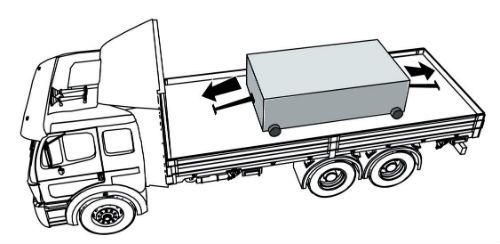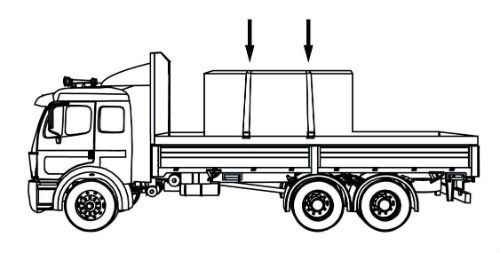CDL Practice Tests: Flatbed Cargo Securement
Choose A Section:
Go!To secure a cubic-shaped boulder, how many tiedowns are required, at minimum?
- 5
- 3
- 2
- 1
Special Circumstances: Securing a Cubic-Shaped Boulder
The securement of a cubic-shaped boulder must meet these requirements in addition to the other large boulder requirements in Section 13.

Secure each boulder individually with at least two chain tiedowns placed side-to-side across the vehicle.
Place tiedowns as closely as possible to the hardwood blocking used to support the boulder.
When a tiedown is attached directly to the cargo, what is the ideal angle where it attached to the vehicle?
- Less than 45 degrees.
- Between 45 and 60 degrees.
- 90 degrees.
- It doesn't matter.
The angle where the tiedown attaches to the vehicle should be shallow, not deep (ideally less than 45).
Securing heavy vehicles or equipment with crawler tracks or wheel requires a minimum of how many tiedowns?
- 2
- 6
- It depends on the weight of the load
- 4
Special Circumstances: Securing Heavy Vehicles, Equipment, or Machinery with Crawler Tracks or Wheels
Tiedown requirements
- Restrain cargo using a minimum of four tiedowns, each having a WLL of at least 2,268 kg (5,000 lb.).
- Prevents cargo movement in the side-to-side, forward, rearward, and vertical directions.
-
Attach tiedowns:
- Either at the front and rear of the vehicle.
- Or at the mounting points on the vehicle designed for that purpose.
The aggregate WLL for logs loaded lengthwise must be at least:
- 1/2 the weight of the stack.
- 4,000 lbs
- 1/2 the weight of the load.
- 1/6 the weight of the stack.
Working load limit for longwood and shortwood loaded lengthwise
The aggregate working load limit for all tiedowns must be no less than 1/6 the weight of the stack of logs.
Note: This requirement is much less than the general requirement of an aggregate working load limit equal to 1/2 the weight of the load. This lowered requirement recognizes that the bunks/stakes help to prevent slippage.
When loading and securing a boulder, it should be:
- Placed on the vehicle with its largest or flattest side down.
- Placed on symmetrical hardwood blocking that extends 3/4 of the length of the boulder.
- Supported on at least 2 pieces of 4in x 4in hardwood blocking, extending the full width of the boulder.
- All of these are requirements.
Requirements

Place each boulder on the vehicle with its flattest and/or largest side down.

Support each boulder on at least two pieces of hardwood blocking (at least 10 cm x 10 cm (4 x 4 in) that extend the full width of the boulder.
Place hardwood blocking pieces as symmetrically as possible under the boulder so they support at least 3/4 of the length of the boulder.
Requirements for securing a non-cubic shaped boulder with a stable base include all of the following except:
- Pass the tiedowns over the center of the boulder
- Attach chains together at the intersection
- Secure each boulder individually with at least two chain tiedowns forming an X pattern over the boulder.
- Wrap chains around the circumference of the boulder.

Secure each boulder individually with at least two chain tiedowns forming an X pattern over the boulder.
Pass the tiedowns over the center of the boulder and attach them to each other at the intersection by a shackle or other connecting device.
When securing rolls of paper with eyes vertical, how many points of contact are required to consider a roll secure?
- 2
- 4
- 3
- 1

Usually the roll is secure if a paper roll has 3 well-separated points of contact with the vehicle, other rolls, or other cargo.
To satisfy general cargo securement requirements, what is the minimum WLL for securing vehicles under 10,000 lbs?
- 4,500 lbs.
- 30% of the weight of the cargo.
- 50% of the weight of the cargo.
- 10,000 lbs.
Note: More tiedowns may be required to satisfy the general cargo securement requirements. The Standard states: "The sum of the working load limits from all tiedowns must be at least 50% of the weight of the cargo."
In cargo securement, what is a 'cleat' defined as?
- A tapered or wedge-shaped piece used to secure round articles against rolling.
- Part of the structure, fitting, or attachment on a vehicle or cargo to which a tiedown is attached.
- A tapered piece of material, thick at one end and thin at the other.
- A short piece of material, usually wood, nailed to the deck to reinforce blocking.
Cleat:
A short piece of material, usually wood, nailed to the deck to reinforce blocking.
Concrete pipe loaded crosswise generally:
- All of these things apply.
- At least one tiedown through the rear pipe of the bottom tier must run forward at an angle not more than 45 with the horizontal when viewed from the side of the vehicle, when ever practical.
- Note: At least one tiedown through the front pipe of the bottom tier must run rearward at an angle not more than 45 with the horizontal when viewed from the side of the vehicle, when ever practical.
- Concrete pipe with an inside diameter up to 1.143 m (45 in) can form a complete single tier on a typical flatbed vehicle. Larger pipe often can only be carried as a partial tier.
Special Circumstances: Securing Pipe with an Inside Diameter Up to 1.143 mm (45 in)
Concrete pipe with an inside diameter up to 1.143 m (45 in) can form a complete single tier on a typical flatbed vehicle. Larger pipe often can only be carried as a partial tier.
Note: This pipe diameter of 1.143 m (45 in) is simply a convenient breaking point between "medium" and "large" diameter pipe.
Note: At least one tiedown through the front pipe of the bottom tier must run rearward at an angle not more than 45 with the horizontal when viewed from the side of the vehicle, when ever practical.
At least one tiedown through the rear pipe of the bottom tier must run forward at an angle not more than 45 with the horizontal when viewed from the side of the vehicle, when ever practical.
About The Flatbed Cargo Securement CDL Manual
Studying the flatbed cargo securement CDL manual is not a requirement for getting your CDL permit or license. It is required knowledge for flatbed drivers.
Some questions you should be able to answer for flatbed cargo securement:
- What is the minimum Working Load Limit of a tiedown used to secure logs?
- What is the minimum weight of a shipment of paper rolls that would require specific securement requirements?
- When securing concrete pipe over 45 inches loaded crosswise, which direction must the tiedowns on the front half of the load run?
- What is a cab shield?
- When securing concrete pipe over 45 inches loaded crosswise, which direction must the tiedowns on the rear half of the load run?
- What is a dunnage bag?
- Who is responsible for inspecting securing devices and cargo within the first 50 miles?
- How many tiedowns are required on a stack of shortwood loaded crosswise?
- What is the minimum working load limit of each tiedown used to secure crushed or flattened vehicles?
- Define 'bolster'
- What is a hook-lift container?
- When a tiedown is attached directly to the cargo, what is the ideal angle where it attached to the vehicle?
What is a securing device?
Any device specifically manufactured to attach or secure cargo to a vehicle or trailer:
- Synthetic Webbing
- Chain
- Wire rope
- Manila rope
- Synthetic rope
- Steel strapping
- Clamps and latches
- Blocking
- Front-end structure
- Grab hooks
- Binders
- Shackles
- Winches
- Stake pockets
- D-rings
- Webbing ratchet
- Bracing
- Friction mat
What is a tiedown?
A combination of securing devices that forms an assembly that:
- Attaches cargo to, or restrains cargo on a vehicle.
- Is attached to anchor point(s).

Some tiedowns are attached to the cargo and provide direct resistance to restrain the cargo from movement.

Some tie-downs pass over or through the cargo. They create a downward force that increases the effect of friction between the cargo and the deck. This friction restrains the cargo.
 Related Cargo Securement Terms That Every Driver Should Know:
Related Cargo Securement Terms That Every Driver Should Know:
-
Tiedown:
A combination of securing devices which form an assembly that attaches cargo to, or restrains cargo on, a vehicle or trailer, and is attached to anchor point(s).
-
Contained:
Cargo is contained if it fills a sided vehicle, and every article is in contact with or sufficiently close to a wall or other articles so that it cannot shift or tip if those other articles are also unable to shift or tip.
-
Blocking:
A structure, device, or another substantial article placed against or around an article to prevent horizontal movement of the article.
How should tiedowns be attached?
Tiedowns can be used in two ways:
-
Attached to the cargo:
- Tiedowns attached to the vehicle and attached to the cargo.
- Tiedowns attached to the vehicle, pass through or aroundan article of cargo, and then are attached to the vehicle again.
-
Pass over the cargo:
- Tiedowns attached to the vehicle, passed over the cargo, and then attached to the vehicle again.
Tiedown placement:

Place the tiedown as close as possible to the spacer.
Position the tiedowns as symetrically as possible over the length of the article.

Position the tiedowns to preserve the integrity of the article.







 TT On Facebook
TT On Facebook